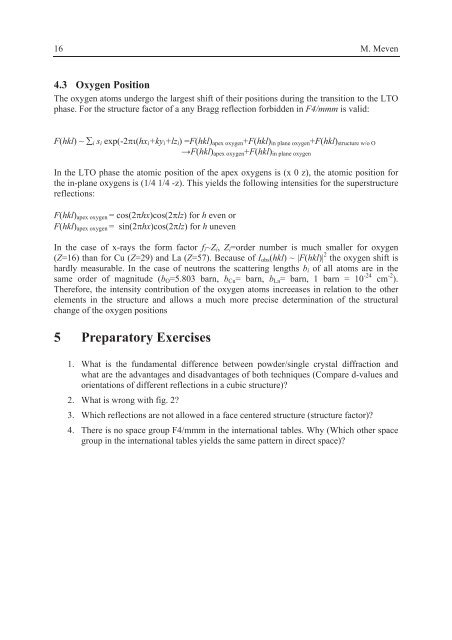Neutron Scattering - JUWEL - Forschungszentrum Jülich
Neutron Scattering - JUWEL - Forschungszentrum Jülich
Neutron Scattering - JUWEL - Forschungszentrum Jülich
Create successful ePaper yourself
Turn your PDF publications into a flip-book with our unique Google optimized e-Paper software.
16 M. Meven<br />
4.3 Oxygen Position<br />
The oxygen atoms undergo the largest shift of their positions during the transition to the LTO<br />
phase. For the structure factor of a any Bragg reflection forbidden in F4/mmm is valid:<br />
F(hkl) ~ �i si exp(-2��(hxi+kyi+lzi) =F(hkl)apex oxygen+F(hkl)in plane oxygen+F(hkl)structure w/o O<br />
�F(hkl)apex oxygen+F(hkl)in plane oxygen<br />
In the LTO phase the atomic position of the apex oxygens is (x 0 z), the atomic position for<br />
the in-plane oxygens is (1/4 1/4 -z). This yields the following intensities for the superstructure<br />
reflections:<br />
F(hkl)apex oxygen = cos(2�hx)cos(2�lz) for h even or<br />
F(hkl)apex oxygen = sin(2�hx)cos(2�lz) for h uneven<br />
In the case of x-rays the form factor fi~Zi, Zi=order number is much smaller for oxygen<br />
(Z=16) than for Cu (Z=29) and La (Z=57). Because of Iobs(hkl) ~ |F(hkl)| 2 the oxygen shift is<br />
hardly measurable. In the case of neutrons the scattering lengths bi of all atoms are in the<br />
same order of magnitude (bO=5.803 barn, bCu= barn, bLa= barn, 1 barn = 10 -24 cm -2 ).<br />
Therefore, the intensity contribution of the oxygen atoms increeases in relation to the other<br />
elements in the structure and allows a much more precise determination of the structural<br />
change of the oxygen positions<br />
5 Preparatory Exercises<br />
1. What is the fundamental difference between powder/single crystal diffraction and<br />
what are the advantages and disadvantages of both techniques (Compare d-values and<br />
orientations of different reflections in a cubic structure)?<br />
2. What is wrong with fig. 2?<br />
3. Which reflections are not allowed in a face centered structure (structure factor)?<br />
4. There is no space group F4/mmm in the international tables. Why (Which other space<br />
group in the international tables yields the same pattern in direct space)?

















